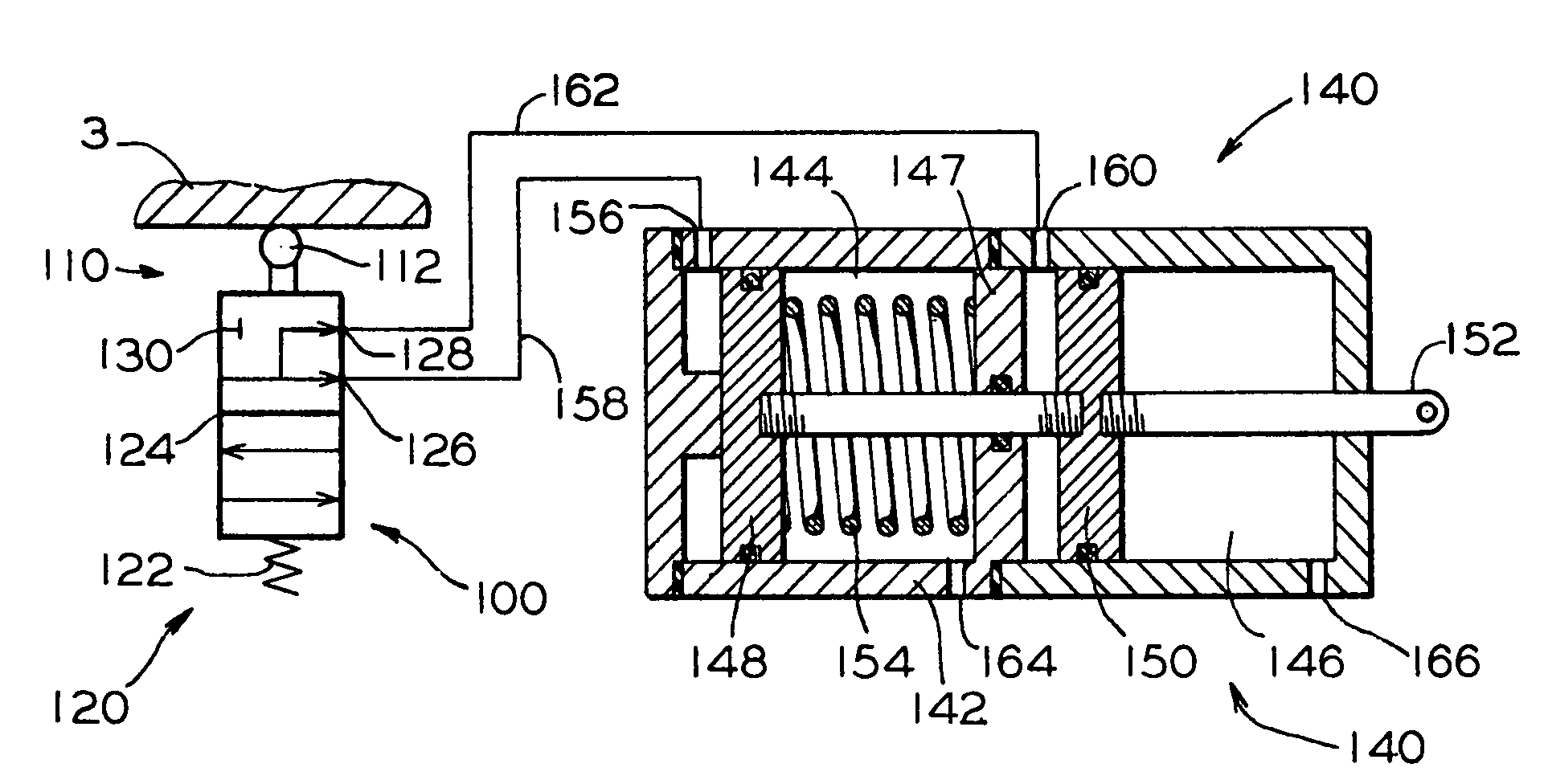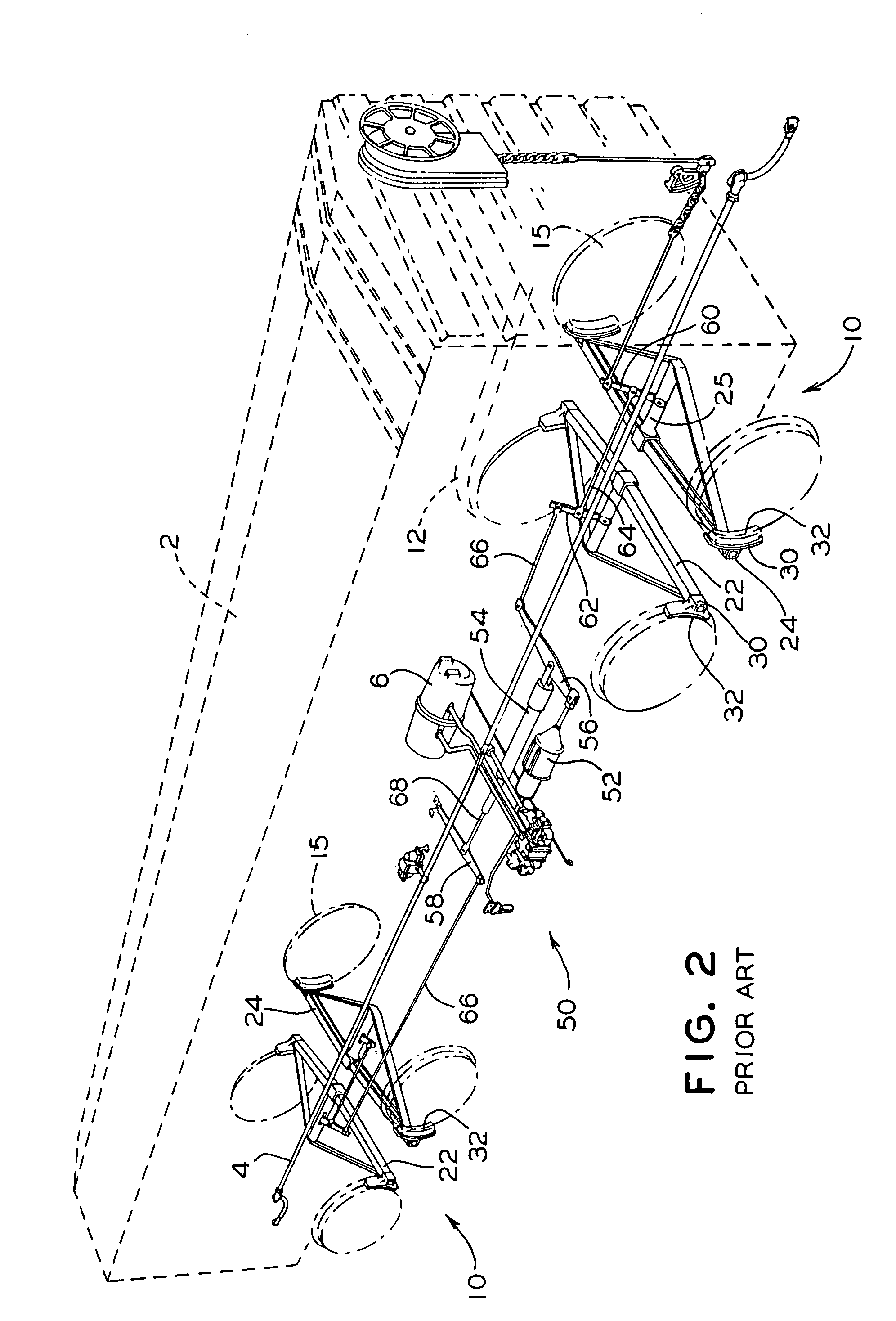Brake system with integrated car load compensating arrangement
a technology of load compensating arrangement and brake system, which is applied in the direction of brake system, fluid actuated drum brake, hoisting equipment, etc., can solve the problems of undesirable situation and the large load imposed by the cars on their respective wheel trucks, and achieve the effect of high braking efficiency
- Summary
- Abstract
- Description
- Claims
- Application Information
AI Technical Summary
Benefits of technology
Problems solved by technology
Method used
Image
Examples
first embodiment
[0024]In the present invention, best shown in FIG. 3, there is means, generally designated 100, for sensing a load on the railway car 2 and generating at least one control signal responsive to such load. Preferably, such means 100 is a valve means which includes a linearly movable means 110 cooperating with a predetermined portion 3, vertically movable, of the railway car 2 or the movable bolster member 16 to sense a vertical position thereof and means, generally designated 120, attached directly to the side frame 12 or to an intermediate member (not shown) attached to such side frame 12 and engageable with or connectable to such sensor means 110 to generate at least one control signal responsive to the position of such predetermined portion 3 or the bolster member 16.
[0025]It will be appreciated that the mounting of the sensor means 110 and signal generating means 120 may be reversed without affecting operation of the present invention.
[0026]Preferably, the sensor means 110 is prov...
second embodiment
[0032]In the present invention, best shown in FIG. 4, either the brake system 20 of FIG. 1 or the brake system 50 of FIG. 2 is provided with an actuator, generally designated 180, comprising a first air spring actuator 182 having an inlet port 184 connectable to first outlet port 126 of the flow control valve 120 via the first control line 158. Such first air spring actuator 182 is disposed within a second air spring actuator 188 which has an inlet port 190 connectable to the second outlet port 128 of the flow control valve 120 via the second control line 162. The first and second air spring actuators 182 and 188 are attached to a rigidly disposed mounting means 194 at one end and to a push rod 196 at a distal end.
[0033]In operation, when the railway car 2 is at its empty load weight, the flow control valve 120 will be in the first flow condition and will pass fluid pressure, upon initiation of the braking sequence, through the first output port 126 through the first control line 15...
third embodiment
[0036]In the present invention, best shown in FIG. 5, there is a means, generally designated 200, for sensing a load on the railway car 2, which includes linearly movable sensor means 210 cooperating with a predetermined portion 3, vertically movable, of the railway car 2 to sense the position of such predetermined portion 3 and means, generally designated 220, attached to a rigid structure and engageable with such sensor means 210 to generate at least one control signal proportional to the position of such predetermined portion 3.
[0037]In such embodiment, the signal generating means 220 is a metering control valve 220 including a housing 222, a stem 224 mounted for linear reciprocal movement within the housing 222 and connectable to means 210 at one end. The other end of the stem 224 is adapted with a seat means 226 engageable with an orifice 228. There is an inlet port 230 connected to the source of fluid pressure, such as brake pipe 4, and an outlet port 232 having a connection w...
PUM
 Login to View More
Login to View More Abstract
Description
Claims
Application Information
 Login to View More
Login to View More - R&D
- Intellectual Property
- Life Sciences
- Materials
- Tech Scout
- Unparalleled Data Quality
- Higher Quality Content
- 60% Fewer Hallucinations
Browse by: Latest US Patents, China's latest patents, Technical Efficacy Thesaurus, Application Domain, Technology Topic, Popular Technical Reports.
© 2025 PatSnap. All rights reserved.Legal|Privacy policy|Modern Slavery Act Transparency Statement|Sitemap|About US| Contact US: help@patsnap.com



